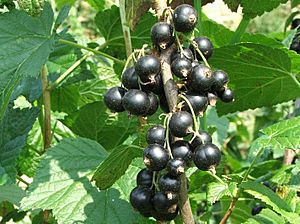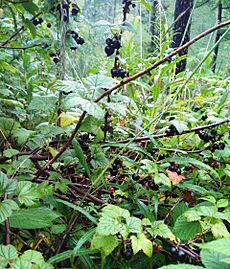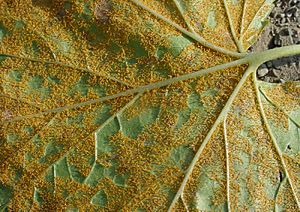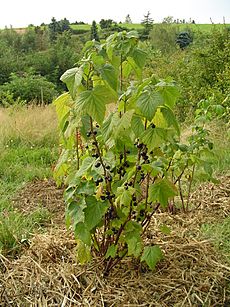Blackcurrant production in the United States facts for kids
Blackcurrant production in the United States has a unique history. The blackcurrant (Ribes nigrum) is a small, dark berry. English settlers brought it to America in 1629. It was grown in places like New York. However, blackcurrant plants can carry a disease called white pine blister rust. This disease harms white pine trees, which were important for the timber industry.
Because of this risk, the US government banned growing, selling, and moving blackcurrants in 1911. This was done to protect the pine trees. The government even used chemicals to destroy blackcurrant plants.
The national ban was lifted in 1966. Many states kept their own bans for a while. Scientists later found that blackcurrants could be grown safely away from pine trees. Also, new types of blackcurrants were developed that could not get the rust disease. By 2003, most states had lifted their bans. Today, blackcurrants are grown for sale in the Northeastern United States and the Pacific Northwest. But because of the long ban, most Americans have never tried a blackcurrant.
Contents
The Story of Blackcurrants
The blackcurrant plant is a woody bush. It comes from Europe. It's related to other berries like red currants and gooseberries. Its branches have flowers and small, black berries.
When English settlers came to America, they brought blackcurrants with them. This was in 1629. By the late 1800s, many acres of these plants were grown. New York was a big center for growing them. But blackcurrants were not very popular. People liked red and white currants more. In 1925, some even said blackcurrants had a "stinking" taste!
The Pine Tree Problem
Blackcurrant plants can carry a disease called white pine blister rust. This rust mostly affects five-needle pines, like the Eastern White Pine. The blackcurrant plants usually don't get sick from the rust. But the disease can seriously harm or even kill pine trees. Blackcurrants are especially likely to carry this rust compared to other similar plants.
In the early 1900s, there were not many ways to treat this rust. The disease was a big threat to America's lumber industry. So, in 1911, the government banned blackcurrants. They also started programs to remove the plants. Workers, including those from the Civilian Conservation Corps, helped spray chemicals to destroy them.
Over time, scientists learned more about the rust. They found that pine trees only get the rust if blackcurrants are grown very close by. Also, the conditions need to be moist. The national ban on blackcurrants was lifted in 1966. Each state then decided its own rules.
In the 1970s, new types of blackcurrants were created. These types were immune to the white pine rust. Some farmers in New York started growing these new types. Even though they were still technically banned, officials often allowed them. New York's ban was finally lifted in 2002. This happened after a farmer worked hard to change the law. Even though pine trees are not used for lumber as much now, some people in the forestry business still protested.
Where Are Blackcurrants Grown Now?
The long ban made it hard for blackcurrants to become popular. They were rarely seen in the US until the national ban ended. By 2019, they were being grown for sale in the Northeastern United States and the Pacific Northwest.
The United States Department of Agriculture doesn't keep exact records on blackcurrant farming. But they do list where these plants have been introduced. Here are some of the areas:
- Connecticut: Fairfield, Hartford, and New London Counties
- Illinois: Lake County
- Maine: Knox, Penobscot, and Somerset Counties
- Maryland: The whole state
- Massachusetts: Essex, Hampshire, Middlesex, Norfolk, and Plymouth Counties
- Michigan: Houghton and Washtenaw Counties
- Minnesota: Kandiyohi, Lake, Ramsey, and St. Louis Counties
- New Hampshire: Coös and Strafford Counties
- New Jersey: Bergen, Sussex, and Union Counties
- New York: Cattaraugus, Chenango, Columbia, Erie, Franklin, Fulton, Nassau, Oswego, and Rensselaer Counties
- Ohio: The whole state
- Oregon: Wallowa County
- Wisconsin: Brown, Dane, and Waupaca Counties
Blackcurrants in the US vs. Europe

Blackcurrants are not widely used in the United States. This is mainly because they were banned for so long. A professor named Danny L. Barney said in 2009 that people "simply forgot about them." He also noted that there are so many other fruits available. Another professor, Marvin Pritts, thinks that less than 0.1% of Americans have ever eaten a blackcurrant.
This is very different from Europe. Europe grows most of the world's blackcurrants. There, blackcurrant is a very popular flavor for drinks like squash (a type of fruit syrup). In the United Kingdom, blackcurrant squash became popular during World War II. It was a good source of vitamin C. In fact, 90% of all blackcurrants grown in Britain are sold to the Ribena company, which makes blackcurrant drinks.
Europe didn't have many large pine tree farms. So, blackcurrants were never banned there. Because of the ban in the US, purple Skittles are grape-flavored in America. But in the United Kingdom and some European countries, they are blackcurrant-flavored!





